Pistoleras
The duel as an archetypal cinematic arrangement: shot, countershot, extended time, confrontation, violence, men. Everything is different in Pistoleras. Precisely placed symbols – a score that sounds like a spaghetti Western, a costume of jeans and a cowboy hat – evoke an entire cinematic tradition by using minimal means, only to immediately toss it all overboard. The attitude is (not) an American one. The cowgirl stands there with her legs apart, but the quick grab at her hip – where a Colt is usually hanging – reveals bare skin and soft flesh. Oval cut-outs on both sides of the jeans allow disarmingly intimate views of the female body that no male gaze would ever have been able to capture. While a Western typically delights in more or less baroque death choreographies at the end of each duel, Pistoleras turns into a sophisticated and mischievous game of mirrors. The cowgirl trudges through tall grass and is self-sufficient, both challenger and challenged, is one, two, many. The agonal and mirror-like symmetry of the classic duel is overridden by using a mirror, of all things, throwing the composition into disorder and confusingly subverting all of the (visual) relationships. The viewer asks herself: What is real, what is virtual, what is surface, what is space? Mirrors are a prop with a long tradition in feminist experimental film, as tools for self-exploration and reflection. In Pistoleras, however, they in no way serve to construct images that would confirm and fix identity – the protagonist’s face is never seen in the mirror. Instead we get multiplicities, like grasses moved by the wind, and formless ephemera, like the clouds seen in the pale gray sky. (Elena Meilicke)
Translation: John Wojtowicz
Pistoleras
2023
Austria
2 min



